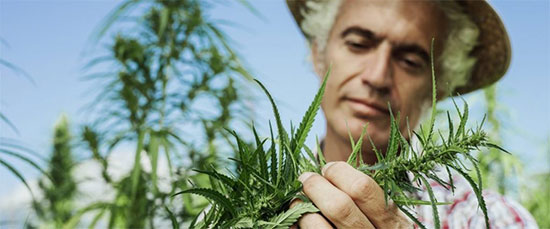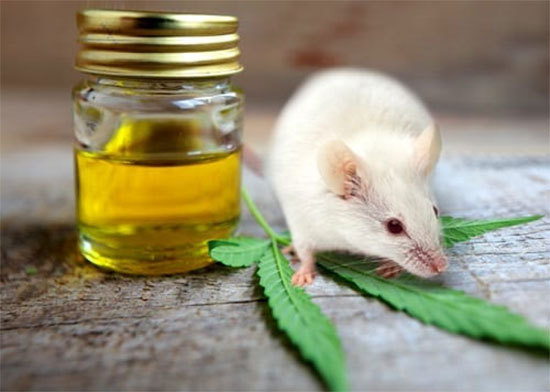Cannabidiol Reduces Aggressiveness, Study Concludes
Experiments with mice performed by Brazilian scientists show that a substance derived from cannabis plants attenuates isolation-induced aggressive behavior.

A recent study has concluded that cannabidiol attenuates the aggressiveness induced by social isolation. The research, based on a mouse model, was performed by scientists at the University of São Paulo’s Ribeirão Preto Medical School (FMRP-USP) in Brazil. The results are published in the journal Progress in Neuro-Psychopharmacology and Biological Psychiatry.
“Our study shows that cannabidiol can inhibit aggressiveness and that it does so by facilitating the activation of two receptors: the 5-HT1A receptor, responsible for the effects of the neurotransmitter serotonin, and the CB1 receptor, responsible for the effects of endocannabinoids,” said Francisco Silveira Guimarães, professor at FMRP-USP and leader of the study.
Although it is extracted from marijuana, cannabidiol does not produce dependency or have psychotomimetic (psychosis-like) effects, Guimarães stressed. The component of marijuana responsible for these effects is tetrahydrocannabinol (THC). Cannabidiol actually inhibits some effects of THC.
“Cannabidiol has been studied in various contexts for the past 20 years, but very little research has been done into its effects on aggressive behavior,” Guimarães said.
Scientists at the University of São Paulo’s Center for Applied Research in Neuroscience (NAPNA-USP) also contributed to the study, which was part of the São Paulo Research Foundation – FAPESP funded Thematic Project “New perspectives in the use of drugs that modify atypical neurotransmitters in the treatment of neuropsychiatric disorders”. The study was also supported by the National Council for Scientific and Technological Development (CNPq), a Brazilian government agency.
Isolation-induced aggression is a classical behavioral model used in experiments, Guimarães explained. “Isolation-induced aggression can be attenuated by the administration of anxiolytic, anti-depressant or anti-psychotic drugs. Preclinical and clinical studies have shown that cannabidiol has these properties, so we decided to test its effect on induced aggressiveness,” he said. “We used a model known as the resident-intruder test, which induces aggressiveness in an animal kept in isolation for several days.”
To determine whether the effects of cannabidiol could alter the resident’s aggressive behavior, the researchers injected four groups, each comprising six to eight male mice, with different doses.
A fifth group acted as a control and was not given cannabidiol. The mice in this group displayed classical resident-intruder behavior. The first attacks by residents on intruders occurred two minutes after they were confronted on average. Between 20 and 25 attacks were recorded while the animals were in the same cage.
In the first group, resident mice received a cannabidiol dose equivalent to 5 milligrams per kilo (mg/kg). Each male weighed 30-40 grams. Attacks began approximately four minutes after intruders entered the cage, double the time taken for control mice to begin attacking intruders, and the number of attacks fell by half.

The second group received 15 mg/kg and behaved less aggressively than any of the others. Attacks began 11 minutes after the intruder’s arrival on average, and the number of attacks averaged only approximately five per cage.
The third and fourth groups received 30 mg/kg and 60 mg/kg, respectively, but these higher doses did not result in more intense inhibition of their aggressiveness. In contrast, attacks began sooner, and the number of attacks was also slightly higher.
“This reduction in the effect of cannabidiol at higher doses was expected from the results of other studies. In experiments to investigate its potential as an antidepressant, for example, higher doses led to lower effects after an initial gain. In our experiment, if we had tested 120 mg/kg on a group of mice, we might not have obtained any inhibition of the resident’s aggressiveness at all,” Guimarães said.
Blocking the effect
Because the scientists already knew that cannabidiol facilitates activation of the 5-HT1A serotonin receptor, they repeated the resident-intruder model in a second batch of experiments, but now administered different doses of the 5-HT1A receptor antagonist WAY100635. The aim was to determine whether the anti-aggressive effect of cannabidiol could be cancelled out or attenuated using WAY100635, as the researchers hypothesized.
“That was indeed the case. In resident mice given intermediate doses of WAY100635 before cannabidiol, the time it took for the first attack to occur after the intruder entered the cage was very close to the time taken by residents in the control group to attack. Control mice weren’t given the drug and began attacking intruders after about two minutes,” Guimarães said.
The same applied to the number of attacks. All mice given WAY100635 before cannabidiol, regardless of the dose, attacked intruders almost as many times as the controls.
Data from the literature and the laboratory itself suggest that cannabidiol also inhibits an enzyme that metabolizes the endocannabinoid anandamide. Endocannabinoids are neurotransmitters produced throughout the central nervous system, including the brain. Anandamide binds to type 1 cannabinoid receptors (CB1), which are also activated by THC, the main psychoactive cannabinoid in marijuana.
To determine whether this mechanism might also be involved in the anti-aggressive effect of cannabidiol, the researchers conducted a resident-intruder test using AM251, a CB1 receptor antagonist, combined with cannabidiol. The results were similar.
“The anti-aggressive effect of cannabidiol was attenuated by WAY100635, the 5-HT1A receptor antagonist, when dosed at 0.3 mg/kg, and by AM251, the CB1 receptor antagonist, at 1 mg/kg, suggesting that cannabidiol attenuates isolation-induced aggressive behavior by means of a mechanism associated with activation of 5-HT1A receptors and CB1 receptors,” Guimarães said. “We don’t yet know how the 5-HT1A and CB1 receptors affect aggressiveness in mice, but the activation mechanisms involved appear to be different in each case.”
yogaesoteric
April 2, 2020
